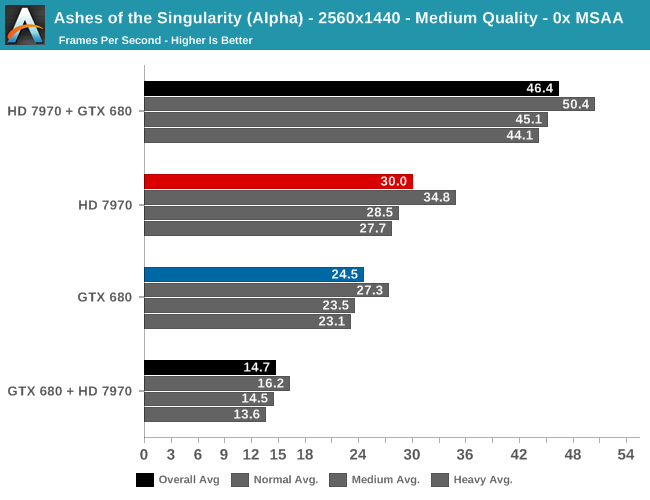GeForce + Radeon: Previewing DirectX 12 Multi-Adapter with Ashes of the Singularity
by Ryan Smith on October 26, 2015 10:00 AM ESTAshes GPU Performance: Single & Mixed 2012 GPUs
While Ashes’ mutli-GPU support sees solid performance gains with current-generation high-end GPUs, we wanted to see if those gains would extend to older DirectX 12 GPUs. To that end we’ve put the GeForce GTX 680 and the Radeon HD 7970 through a similar test, running the Ashes’ benchmark at 2560x1440 with Medium image quality and no MSAA.

First off, unlike our high-end GPUs there’s a distinct performance difference between our AMD and NVIDIA cards. The Radeon HD 7970 performs 22% better here, just averaging 30fps to the GTX 680’s 24.5fps. So right off the bat we’re entering an AFR setup with a moderately unbalanced set of cards.
Once we do turn on AFR, two very different things happen. The GTX 680 + HD 7970 setup is an outright performance regression, with performance 40% from the single GTX 680 Ti. On the other hand the HD 7970 + GTX 680 setup sees an unexpectedly good performance gain from AFR, picking up a further 55% to 46.4fps.
As this test is a smaller number of combinations it’s not clear where the bottlenecks are, but it’s none the less very interesting how we get such widely different results depending on which card is in the lead. In the GTX 680 + HD 7970 setup, either the GTX 680 is a bad leader or the HD 7970 is a bad follower, and this leads to this setup spinning its proverbial wheels. Otherwise letting the HD 7970 lead and GTX 680 follow sees a bigger performance gain than we would have expected for a moderately unbalanced setup with a pair of cards that were never known for their efficient PCIe data transfers. So long as you let the HD 7970 lead, at least in this case you could absolutely get away with a mixed GPU pairing of older GPUs.










180 Comments
View All Comments
Grimsace - Tuesday, October 27, 2015 - link
Nvida and AMD both have a history of re-branding cards with the same gpus. Nvidia SLI requires that the cards are the exactly the same model (i.e. GTX 760 with another GTX 760). While AMD still allow you to crossfire the cards as long as they have the same basic architecture (i.e. Radeon 7870 and an R9 280X).Ryan Smith - Monday, October 26, 2015 - link
"What about pairing the IGP with a low end discrete part where the performance gap is much smaller? "Right now it would still be too slow. Oxide is only ready to test Ashes on high-end hardware at this point.
"This pre-beta requires very high-end hardware and should only be joined by people with substantial technical expertise and experience in real-time strategy games.
These builds are buggy, gameplay is very incomplete and it'll probably kill your pets."
Which is not to say that I'm not curious as well. But it's one of those matters where Ashes needs some more development work before they're ready to show off any kind of fusion involving an iGPU.
JamesDax3 - Monday, October 26, 2015 - link
Intel iGPUs may not be up to par but AMD APUs should be. Would love to see this done with an A10-7870K paired with a R7 360/370 or GTX 950/960.naretla - Tuesday, October 27, 2015 - link
Intel Iris Pro actually outperforms AMD APUs: http://www.tomshardware.com/reviews/intel-core-i7-...silverblue - Tuesday, October 27, 2015 - link
...for double the price. Will Intel's parts also benefit from DX12?nathanddrews - Tuesday, October 27, 2015 - link
It always costs more to get better performance. Why would that suddenly change in the case of Iris Pro vs APU? If you recall, Intel has been showing DX12 demos on Haswell, Broadwell, and Skylake for some time now. Skylake has been confirmed to support feature level 12_1.silverblue - Tuesday, October 27, 2015 - link
That doesn't necessarily mean it'll perform better at DX12 than in DX11; ask NVIDIA. However, NVIDIA's DX11 performance is that good, it's little surprise they're not benefitting with DX12.It does cost more to get better performance, you're right, however until Broadwell, Intel hadn't provided something to challenge AMD on the desktop. Intel's CPUs generally did cost more regardless of the strength of their IGP.
nathanddrews - Wednesday, October 28, 2015 - link
I'm not sure I follow your post. Intel is more expensive than AMD because they get better CPU performance AND better IGP performance (Iris Pro only). They have also shown - in demos and game engines - that DX12 performance is better than DX11 performance.Not sure what NVIDIA has to do with this...
looncraz - Wednesday, October 28, 2015 - link
It better for twice the money!AMD could easily build an APU twice as fast, but memory bandwidth is a real issue.
We will see what they have up their sleeves on the coming year...
patrickjp93 - Wednesday, October 28, 2015 - link
How can bandwidth be the issue when Intel gets around it so easily? Even without eDRAM HD 6000 smacks Kaveri upside the head. Maybe Intel's just better at the integrated game...